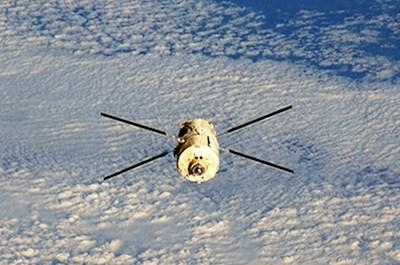Orion European Service Module (ESM) Built On ATV Foundation
Ten years as prime contractor for ESA – it’s just the beginning for Airbus in human spaceflight: The successful mission of the first Airbus-built ATV (Automated Transfer Vehicle) “Jules Verne”, launched on 9 March 2008, has become a key element of pioneering technologies for human spaceflight that includes Spacelab, the ATVs and the Columbus module of the International Space Station (ISS).

Together they pave the way to the Orion European Service Module (ESM), Europe's latest contribution to human spaceflight developed by Airbus, again as prime contractor.
NASA's Orion spaceship is designed to take humans to the Moon and beyond, with the possibility of even reaching an asteroid and maybe Mars in the 2030s. The ESM integral to the crew module is designed to supply power, propulsion, thermal control, water and air for future human deep-space missions.
Ten days after launch, the first ATV, the sophisticated space freighter executed a perfect maneuver to dock automatically with the ISS. The ATV then not only delivered vital supplies to the ISS but also successfully carried out its orbit-raising mission and became an integral part of the ISS. After six months docked to the ISS, the first ATV “Jules Verne” detached on 5 September 2008 and began its last journey in Space, which ended with a controlled burn up on re-entry into the Earth’s atmosphere on 29 September 2008. Four more ATVs (2011-2014) were sent to the ISS. Airbus was prime contractor to the European Space Agency (ESA) to develop and build all the ATVs and prepare their missions to the ISS.
In total the ATVs shipped more than 31.5 metric tons of supplies to the ISS until 2015. They boosted the Space Station to raise its orbit numerous times and helped manoeuvre it out of the way of space debris. The ATVs demonstrated the ability to dock automatically with the ISS, which is vital technology for future space exploration missions. Airbus achieved this as part of a European partnership and thanks to the ATVs’ outstanding performance, the company became a full partner of NASA for major space programmes.
“Spacelab, Columbus and the ATVs have fully proved our capabilities to develop a highly reliable system that will play an integral part in the success of NASA’s future exploration missions: namely the European Service Module of the Orion Multi-Purpose Crew Vehicle,” said Nicolas Chamussy, Head of Space Systems at Airbus.
The ESM is cylindrical in shape and about four meters in diameter and height. It has four-wing solar arrays (62 feet across when unfurled) like the ATVs. The solar arrays are based on Airbus’ flight proven technology which are also installed on their highly reliable geostationary telecommunication satellites which operate for a minimum of 15 years in Space.
The ESM’s 8.6 metric tons of propellant will power one main engine and 32 smaller thrusters used to perform orbiting manoeuvres and attitude control. Once again, ESA will rely on the experience gained with the ATVs, which successfully used their thrusters to allow the ISS to evade space debris.
“The requirements for a mission to the Moon are of course very different to those for travel to the ISS in low Earth orbit. But the clever design of the ATV has allowed us to evolve the concept for new missions, for example by integrating one large main engine providing enough power to fly to the Moon and back,” said Nicolas Chamussy.
(Image provided with Airbus news release)
 Airborne 04.16.24: RV Update, Affordable Flying Expo, Diamond Lil
Airborne 04.16.24: RV Update, Affordable Flying Expo, Diamond Lil ANN's Daily Aero-Term (04.20.24): Light Gun
ANN's Daily Aero-Term (04.20.24): Light Gun Aero-News: Quote of the Day (04.20.24)
Aero-News: Quote of the Day (04.20.24) Aero-News: Quote of the Day (04.21.24)
Aero-News: Quote of the Day (04.21.24) ANN's Daily Aero-Term (04.21.24): Aircraft Conflict
ANN's Daily Aero-Term (04.21.24): Aircraft Conflict



